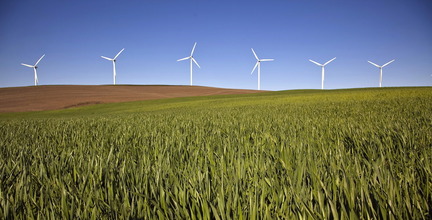forum
library
tutorial
contact

Renewable Energy and the Oregon Trail
by David J. WelchThe Oregonian, December 11, 2009
|
the film forum library tutorial contact |

|
Renewable Energy and the Oregon Trail
by David J. WelchThe Oregonian, December 11, 2009 |
 Most of us agree that the pursuit of renewable energy sources is a necessity. We may not agree on the justification, but in the end we agree a need exists. This recognized need has resulted in a rush to build renewable energy sources without adequate regard for visual and cultural resources. Are we once again making decisions that we will regret in the future?
Most of us agree that the pursuit of renewable energy sources is a necessity. We may not agree on the justification, but in the end we agree a need exists. This recognized need has resulted in a rush to build renewable energy sources without adequate regard for visual and cultural resources. Are we once again making decisions that we will regret in the future?
Of particular concern is the impact of large-scale wind farms and solar fields. I'm especially concerned about impacts to the Oregon National Historic Trail and its setting in eastern Oregon. Beginning about five years ago we began to see wind turbines in the plains between Pendleton and The Dalles. This region is traversed by the Oregon Trail, and while the land is cultivated over much of the area, pristine trail remnants remain in a few places. Even in plowed fields the trail appears as a variant green ribbon when the wheat sprouts to about 6 inches.
For the most part, the trail is avoided by the turbine structures themselves, but road and transmission line crossings are inevitable. The major impact has been to the setting, which up until now has retained a bit of the feeling of the emigrants' journey, in particular the views from the plains of the Cascades and their spectacular volcanoes. Today these views are often disturbed by the presence of 400-foot wind turbines spinning triple 90-foot blades. Spaced closely together, the scene is more like some multiengine aircraft struggling to get airborne rather than an historic emigrant route.
Recently, wind turbine construction has also intruded into the Columbia River Gorge east of The Dalles. This is the route of Lewis and Clark and includes many of their campsites along the way. Another renewable energy source, hydroelectric power, flooded many of the historic sites associated with their journey more than 50 years ago. Sites like Ceililo Falls are irreplaceable.
North of Pendleton, on the edges of the ridges above the Walla Walla Valley, turbines have also sprouted and proliferated over the past 10 years. This is the route of early travelers to the Whitman Mission and the Hudson's Bay Company's Fort Nez Perces. The trail has always been difficult to find in this area, but any prospect of locating it is probably now gone. Until the turbines appeared, the setting was still evocative of the emigrants' and traders' journeys.
One of the most disturbing new proposals is for wind turbines on the ridges at the southern end of the Grand Ronde Valley on historic Ladd Hill. These turbines, like the others I've described, are on private land and thus only subject to the approval of local land-use authorities and the Oregon Energy Facility Siting Council. Regulations require that the siting council consider cultural impacts when developing these facilities, and it can impose conditions, but it cannot reject the project as a whole. It should be noted that the trail through the area contains "high potential segments" as defined by the National Park Service.
South of the Grande Ronde Valley toward Baker City, still more turbines line the trail corridor. In areas where the land is administered by the Bureau of Land Management, wind farm developments are subject to Section 106 actions and as a result are generally sited to minimize the impacts to the trail and its setting.
The question remains: Are we repeating the errors of the past by destroying nearly pristine landscapes and historic sites with a new form of pollution? Is all of this being done to meet an immediate expedient of renewable energy with little view to the future? Is a system and infrastructure being built that due to its inefficiencies will not meet the energy needs for which it is being built? I'm afraid the answer is yes. I don't ask that all of these developments be stopped, but that they proceed in a more considerate manner with regard to their productivity and their impact on cultural resources.
learn more on topics covered in the film
see the video
read the script
learn the songs
discussion forum
